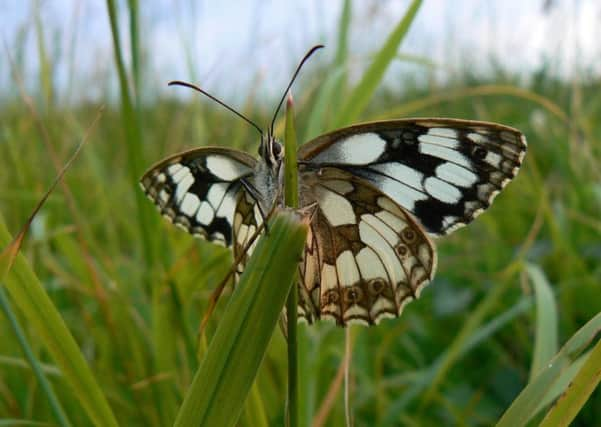Country & Coast: Marbled beauty finds a home at rewilded quarry


Even when you get there, the scene looks uninviting: just a few football pitch lengths of short grass and flowers flanked by the remnants of a chalk quarry on one side and the old Beverley-Market Weighton railway line on the other.
Chalk was excavated across the Yorkshire Wolds as long ago as the Industrial Revolution and made into quicklime for blast furnaces, fertilisers for spreading on high acid farmland, and used in cement and bricks. Most of the workings are no longer active, such as those at Fordon near Camp Dale and Wharram-le-Street at the top end of the Wolds.
Advertisement
Hide AdAdvertisement
Hide AdAt Kiplingcotes, which lies in a narrow fold in the landscape known as the Market Weighton Gap between York and Hull, quarrying operations ceased in 1902 and since then the site has become overgrown with a rich variety of calcium-loving plants.
According to the Yorkshire Wildlife Trust, which has managed Kiplingcotes since 1965, the natural restoration began when species of lichens and moss colonised the exposed chalk face and banks still littered with chalk scree. Later, across the thin soils of the quarry floor grew short-tufted grassland plants like wild pansy, wild thyme and mouse-ear hawkweed. The regeneration continued above the quarry with common and greater knapweed, field scabious and burnet saxifrage.
These classic downland flowers flourish at Kiplingcotes and are responsible for the presence of an inordinate number of butterfly species. Within a few minutes of arrival it is possible to see at least half a dozen of them, and for me they appeared in the order of orange-tip, ringlet, meadow brown, common blue, small heath and large skipper. Then came what has to be the reserve’s signature butterfly, the marbled white, whose lovely black-and-white wings are reminiscent of Art Nouveau lampshades.
It is particularly attracted to the nectar of purple flowers like the scabious and knapweeds, while its caterpillars feed on red fescue. Although the marbled white is common in the south of England the population is patchy elsewhere and virtually non-existent on the west side of the UK. East Yorkshire, though, is very much its northern stronghold.
Advertisement
Hide AdAdvertisement
Hide AdThe marbled white’s preferred habitat is what naturalists call “unimproved grassland”, usually plunging banks which have not been touched by ploughs or harmful agricultural sprays. Despite the Yorkshire Wolds being intensely farmed there are plenty of these areas of chalk meadowland left for the butterfly to flourish.
And there were plenty of them about at Kiplingcotes last week, less fluttering and erratic in flight than the other butterflies and an absolute thrill to watch. They can be extremely obliging for photographers when they stop to feed, soak up the sun or roost on a stalk of grass, and put their eponymous marbling on display.